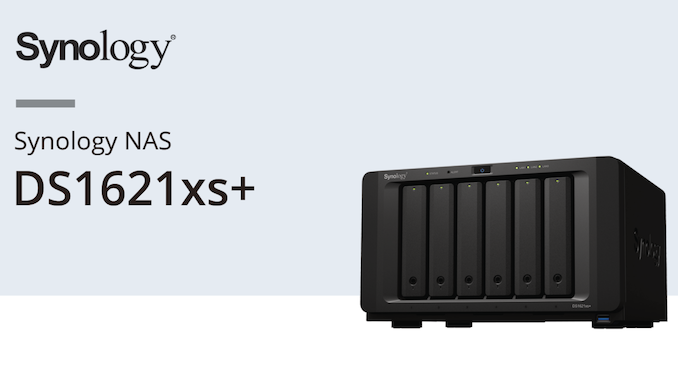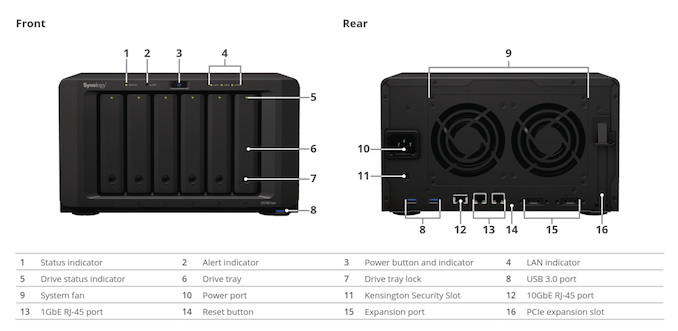Synology Introduces DS1621xs+ - First Desktop x86 DSM NAS with Native 10GbE
by Ganesh T S on September 11, 2020 11:35 AM EST- Posted in
- Storage
- NAS
- Synology
- Xeon-D
- DiskStation

Synology is one of the top-tier vendors in the commercial off-the-shelf (COTS) network-attached storage (NAS) market for SOHOs, SMBs, and SMEs, with QNAP being the other major player. While QNAP has a wide variety of hardware platforms to choose from in each market segment, Synology has been big on segmentation - restricting Xeon CPUs and native 10GbE to their rackmount offerings. Only their Annapurna Labs SoC-based desktop units have had 10G SFP+ support till now. That changed recently with the introduction of the DS1621xs+.
The Synology DS1621xs+ uses a Broadwell-DE Xeon-D processor (D-1527) - These SoCs are a better fit for storage platforms compared to the networking-focused Skylake-D SKUs. The 6 built-in 3.5" hot-swappable drive bays are complemented by two M.2 2280 NVMe SSD slots. There are two 1 GbE LAN ports and a 10GBASE-T port. Two eSATA ports help the unit support two DX517 expansion chassis, allowing the unit to support a total of 16 bays.
On the software side, similar to all other x86 NAS units from Synology, the DS1621xs+ also comes with support for both ext4 and btrfs internal volumes. Synology claims read speeds of up to 3100 MBps with additional 10G NICs in the expansion slots.
| Synology DS1621xs+ Specifications | |
| Processor | Intel Xeon D-1527 (4C/8T Broadwell-DE x86 Cores @ 2.20 (2.70) GHz) |
| RAM | 8 GB DDR4-2666 ECC SODIMM (upgradeable to 16GB x 2) |
| Drive Bays | 6x 3.5"/2.5" SATA 6 Gbps HDD / SSD (Hot-Swappable) (Expandable with 2x DX517 up to 16 bays in total) |
| Network Links | 2x 1 GbE 1 x 10 GbE |
| External I/O Peripherals | 3x USB 3.0, 2x eSATA |
| Expansion Slots | 1x PCIe 3.0 x8 |
| VGA / Display Out | None |
| Full Specifications Link | Synology DS1621xs+ Specifications |
| Price | $1600 (Newegg) |
It is heartening to see Synology finally introduce 10GBASE-T NAS units in the desktop form-factor. The DSM software carries some unique applications (like the Synology Office suite) that QNAP doesn't currently have in their QTS operating system. On the other hand, QNAP's hardware variety - particularly in terms of NBASE-T and 10GbE support even in their SOHO offerings is also attractive. Overall, it is good for consumers to have more options to choose from in the COTS NAS market.
Source: Synology













52 Comments
View All Comments
Duncan Macdonald - Friday, September 11, 2020 - link
As even a single SATA III drive can hit 600MB/sec which is enough to saturate a 5Gbit/sec link, why was 10GbE not introduced years back on NAS systems ?Note that the NVMe drives will be crippled even by a 10GbE. (NVMe data rates are upwards of 2000MB/sec, 10GbE is limited to under 1200MB/sec)
Dug - Friday, September 11, 2020 - link
Cost, power, and infrastructure.Yes, some people went used market for switching, but realistically, the amount of home users that have the wiring or even a want or need for 10, is a very tiny amount. (Most people rent and can't just add cat 6 wherever they want). So it's a risk for a company like Synology to create a $1600 storage device when most will build their own.
nvme is used for cache.
Saturating 5Gb or 10Gb is rare for any home user, doesn't matter what hard drive speed is.
quiksilvr - Friday, September 11, 2020 - link
The reason why 10 gigabit is expensive is because demand for it is low in the consumer space. Demand for it is super high in the enterprise environment but is still incredibly overpriced. It is copper based and requires the weakest ARM based processor and a fan. Companies are just milking it and will continue to do so. We are lucky that it is possible to get a proper 4 port 10 gigabit ethernet + 1 SFP port switch for $350. You can buy a 4 port SFP 10 gigabit for $150 but then you need compatible SFP modules after that.close - Friday, September 11, 2020 - link
Most consumers don;t really want cables at all anymore. Despite the unreliable nature of WiFi the convenience it provides is undeniable. So the market for home wired connections in general isn't that attractive. The market for home 10G copper connections is minute. You only get the benefits once the whole chain supports 10G (network card, cables, switch, whatever is inside the endpoints) and very few people transfer so much data inside the network to bother. In the end they get a laptop that's more expensive, uses more power, a more expensive switch and cables and very little to show for it.I keep seeing people around here being completely ignorant of the reality outside their browser window, talking about how common home labs are and how they *need* 10G, etc. Home labs are actually rarer then hens' teeth in the grand scheme of things, most don't realistically benefit from 10G (I mean faster is always better but law of diminishing returns and all that), and manufacturers have no reason to bump up the price for 99.9% of the people so some guy can move his porn and warez collection from one place to another a bit faster.
I said it once and I'll say it again, whoever *needs* 10G already has it and even for reasonable prices. Like a switch with 8x1G and 2x10G copper can be had for under $200. Even less if used. And if you have a home lab going for SFP is actually a blessing since it's overall cheaper. If you need such a setup you should be qualified enough to configure it yourself and don't mind the medium used.
It's great to have newer and better, no objection there. I'd also like all that enterprise grade equipment to somehow be at consumer price levels. But the whining that people who don't *need* it should somehow subsidize it for the few that *want* it is pathetic.
jeremyshaw - Friday, September 11, 2020 - link
I agree, there isn't a large awareness for actual consumer benefits when it comes to >GbE, largely because there isn't much actually driving that on the consumer side. I would very much like to run an all-fiber SFP+/SFP28 or faster network around the house, but I also have only one PC actually capable of saturating that. Even if I had two, what would I care so much about, that it has to transport across the network at a higher bitrate? Movies aren't going to magically run with more visual quality. Games aren't going to become better. Maybe if I was an editing/studio house with 3-4 editors working on raw high bitrate 8k HDR feeds while mastering on 8k LG OLED panels, I'd have an actual need-driven upgrade path. But for.... a few devices browsing the internet and some streaming media? GbE will have to do.close - Saturday, September 12, 2020 - link
Normally you can get the network part of the 10G (cards, switch, cables, ideally used) as almost a rounding error to how much the costs of the rest of your infrastructure that would *need* it. Very fast machines (clients, NAS) filled with large, fast SSDs. People dish out thousands of $ for fast PCs, fast, loaded NAS, and then snub their noses at a couple of hundreds for the network part?CaptainChaos - Friday, September 11, 2020 - link
I'm one with a home lab who splurged on some 10G stuff (new & used, all short run copper) and come nowhere near utilizing the bandwidth! More than 1G yes, but 2.5 or 5 NbaseT would do just as well for less cash. Most people seem to have little clue about bandwidth and the difference between megabits & megabytes, let alone protocol overhead!close - Saturday, September 12, 2020 - link
I agree but it's not even an issue if you can saturate it. Say you have 2 fast SSDs on each side but how much data do you have to copy and how often for those savings to make a difference?100GB gets copied in ~15 minutes on a 1G connection. I booted up 100 VMs over 1G and even that boot storm wasn't unbearable. So unless you make a living out of moving data fast and your income depends on saving that time, *demanding* 10G is an epeen contest.
And the pathetic part is that some people are basically shouting that they *need* 10G because they do such important stuff but not important enough to take a few hundred $ out of their pocket. Nothing says "important" like saying it has to cost $15 bucks or it's too much. Kind of shrivels the epeen.
Spunjji - Monday, September 14, 2020 - link
2.5Gb is really where it should be at for high-end home usage, and it's finally starting to filter into that market, which is good to see.phatboye - Sunday, September 13, 2020 - link
I would like to respectfully disagree with your comment because conversing about causal consumer electronics in respect to a $1600 16 bay NAS. Very few causal consumers would even consider such a machine for their home usage. That is not even the target purchaser for this piece of equipment so your analogy fails.